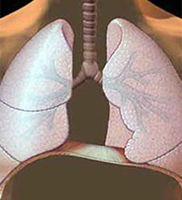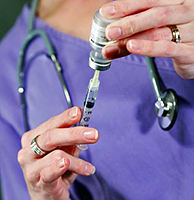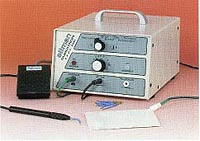How it is carried out and what the results of the surgical method of treatment of lung cancer can give? How the radiation therapy and lung cancer chemotherapy? Answers to these questions you will find in the article.
Content
Chemotherapy and their various combinations. Tactics of treatment are established
taking into account the histological structure and the degree of proliferation of the tumor, and
also the age and functional status of the patient, opportunities and
Clinic Installations.
The main method of the treatment of lung cancer, providing persistent cure, is a timely operation. The history of the surgical treatment of lung cancer
Hours more than 70 years when in 1933. American surgeon Grehem
For the first time successfully performed a combined pneumonectomy.
Despite the continuous improvement of the surgical method, the long-term results of lung cancer operations
practically did not change around the world over the past 30 years and leave
wish the best. Only 30-40% of radically operated lung cancer patients
Survive check 5 years. Most of them have for
2-3 years after the operation, the progression of the tumor process occurs
With the damage to the intragenuous lymph nodes, the residue of the lung or
remote organs. This is due to the peculiarities of the tumor biology,
which at the apparent radicality of the operation is often already
generalized disease.
With the fact that the peculiarity of patients with an established diagnosis of lung cancer is an average of 20-25%, it is obvious that only a small proportion of patients has a chance for recovery. Late diagnosis of lung cancer
determines the large percentage of palliative operations - when in connection with
A large prevalence of the process is clearly unable to completely remove
Tumor fabric. In such cases, surgery is often
aims to eliminate threatening life complications - bleeding,
Void, breakthrough tumor in breast cavity and t.D.
Surgical method for the treatment of lung cancer
Surgical treatment of patients with resectable (potentially removable) forms of lung cancer
is the radical and most encouraging method giving real
Prospects for full cure. After the first successful operations
removal of lung back in the 30s of the twentieth century
Improved, and the greatest successes achieved in the last two
decades. To date, methodical and
Technical aspects of operational interventions, identified indications for
Lung cancer operations and
The choice of its volume, studied the main questions of anesthesiology, intense
therapy before and after surgery, prevention and treatment of postoperative
Complications.
With resectable (potentially removable) forms of non-cellular cell lung cancer (I - III stage) surgical treatment is a choice method. Under the refinement of the testimony to the operation with lung cancer
these stages mean not so much determination of its expediency,
how much is the establishment of the principal possibility of execution
Surgical manual, which is achieved by assessing contraindications.
Over the past two decades, contraindications are sharply narrowed
Oncological and functional plan for surgical treatment
Patients with lung cancer.

In a significant number of patients with lung cancer
There are contraindications for surgery
Functional type. These include low compensatory capabilities
Breathing and blood circulation, serious concomitant diseases
(heart failure II and III degree; pronounced organic
changes in the heart; Hypertension III ST.;
Renal or liver failure, etc.). In the assessment
Contraindications for lung cancer is always present subjective moment.
On the unreasonable refusal of the operation of a patient with lung cancer
The possibilities and practical experience of a medical institution also affect.
Modern features of anesthesiology and intensive therapy allow
Often to prevent violations of the function of organs and systems, especially when
Adequate preoperative preparation. Refusal to operation with
Oncological positions should also be seriously motivated. This
The question must be addressed to collegially with the obligatory participation
Thoracic surgeon having experience in surgical treatment of lung cancer.
Standard operations for lung cancer
are pneumonectomy (removal of all lung) and lobectomy (removal
one share of the lung), as well as their options (expanded and
Combined operation, lobectomy with circular resection
Bronchi and others.). Bronchoplastic operations expand opportunities
the surgical method and contribute to increasing rectaging to
20% Among the first time identified patients with lung cancer
of this localization. The volume and nature of the surgeon operation determines in
depending on the localization and prevalence of the primary tumor, its
Relationships to the surrounding organs and structures, state of intracient
Lymph nodes.
The greatest achievement of recent years is the ability to diagnose truly early forms of central lung cancer
(Carcinoma in situ, microinvasive cancer) that can be cured
not only the operational method, but also radiation (intra-freedom) or photodynamic therapy. With the last patient, lung cancer administered
photosensitizer that accumulates predominantly in cancer
cells, then with the help of bronchoscope, irradiation with rays
Laser of a certain wavelength. Results justify application
method - cure is achieved more than 90% of patients.
Operations for lung cancer
Many dangers are melted, which sometimes leads to intraoperative and / or
Postoperative complications, as well as postoperative mortality
(mortality). Improving operational equipment and
anesthesiological manual, as well as a comprehensive
intensive therapy before surgery and early after it
contributed to a sharp reduction in frequency in recent years
Postoperative complications.
Postoperative mortality - the main indicator in the assessment of the immediate results of the surgical treatment of patients with lung cancer.
In the early years, when surgical treatment began to carry out,
Postoperative mortality was extremely high - up to 25%. IN
The last two decades, progress in surgery led to her noticeable
reduction - about 3-4%.
With the lung stage cancer
The surgical method allows to achieve 70-80% of patients with cure, II
Stages, that is, in metastases in the nearest lymph nodes, - about
40%, and at stage III, i.e., metastatic lesion more
remote groups of lymph nodes - only 15-20%. Most cases
death from recurrence and metastases of lung cancer
account for the first 2-3 years after surgery. If patients are safe
experiencing this critical period and in the control dynamic
Surveillance does not detect the progression of the process, the forecast
is favorable.
Unfortunately, most patients are diagnosed with
Large delay in the III-IV stages, many identify various
Contraindications of the functional plan, and they are recognized by non-cultural.
Elimination of errors in organizing the active identification of early forms
Diseases at the stage of primary and refineering diagnostics of lung cancer,
The use of the most efficient research methods as well
Selection of rational healing tactics, taking into account modern achievements
Clinical oncology, close dispensary observation after
treatment will definitely increase the effectiveness of therapy of this formidable
Diseases.
Radiation therapy in the treatment of lung cancer
The second effective method of treatment of lung cancer is radiation therapy. With non-cellular lung cancer
Rauchery treatment is carried out on a radical program or with
Palliative purpose. Radical radiation therapy provides for
obtaining a long and resistant effect as a result of the death of all
The cells of the primary tumor and intragenuary metastases.
Lightweight Radiation Cancer Cancer
is carried out using remote gamma facilities of betatrons and
Linear accelerators generating brake and electronic radiation
Energies from 4 to 35 MeV. There are many methodological options for ray therapy of lung cancer.
Radical therapy on the radical program is possible in patients with local
tumor process of the lung (I-II stage), which operation
contraindicated or they refused. The cure of such patients
achieved in 5-10% of observations. Radiant therapy for palliative
The program is planned when lung cancer
III Stages. In unadiscally operated patients and
Cancer progression after surgery, radiation therapy is often combined with
Polykhimotherapy.
The immediate effect of light ray therapy for lung cancer
Depends on the prevalence of the process, histological structure
Tumors, values of total focal dose. Half patients manage
achieve full resorption of primary tumor and regional metastases,
and in 40% - reduction of the intrabriety tumor process.
Chemotherapy in the treatment of lung cancer
Lung cancer chemotherapy over the past decades has become more efficient due to the synthesis of new drugs. With small lung cancer
It is the main method of treatment and its effectiveness reaches
60-80%, sometimes with complete resorption (resorption) of the tumor, which really prolongs
life about 50% of patients. With early stages (i) of this histological
Forms of lung cancer for the method of choice is surgical, but necessarily with postoperative multi-course (4-6) polychimotherapy.
With non-cellular lung cancer
Direct objective improvement (partial resorption (resorption) primary
Tumors, regional and remote metastases) during chemotherapy
It is achieved in 10-30% of patients, but complete resorption rarely occurs.
It is carried out in contraindications to surgical and radiating treatment,
as well as an additional treatment for operation
local progressive process, when progressing a tumor after
Surgical treatment.
Polykhimotherapy is carried out for a long time (up to 6-8 courses)
Preparations in various combinations: doxorubicin, prokarbazin,
Cisplatin, Winnistine, etoposide, cyclophosphane, methotrexate,
Bleomycin, Iphosfamide, Irinotecan, Taxother, Taxol, Vinorelbin,
Gemcitabine and others. Intervals between chemotherapy courses - 3-4 weeks.

The best results are achieved with a combination of chemotherapy with radiation therapy of lung cancer (chemo-processing), while it is possible simultaneous or consistent their use.
Possible toxic reactions in chemotherapy include nausea,
Vomiting, intestinal disorders, phlebitis, cystitis, dermatitis, allergic
Reactions and other. The most frequent late complication is oppressed
Bleelms. Therefore, blood tests are repeated at least 2 times a week and
within two weeks after completion of chemotherapy.
Improving the efficiency of surgical treatment of patients with non-cellular cellular cancer of the Easy Stage III is associated with the development of methods of combined treatment, which provides a combination of radical operation with radiotherapy of lung cancer
and / or with medicinal antitumor treatment. Additional methods
apply before or after surgery, during it, as well as in pre- and
Postoperative period. Many of the combined treatment of lung cancer
remain debated and unclear. However, it is obvious that at the III stage
The results of combined treatment are better than one surgical.
Often patients with plasticized lung cancer
Enroll in hospital with severe respiratory failure on the background
Obstructions (blockage) tumor trachea and large bronchi when speech
There is primarily about emergency to eliminate threatening
Life of respiratory and pulmonary heart failure. Designed
Algorithm for the treatment of this contingent of patients with lung cancer using high-tech modern methods.
Summarizing all the above, it can be concluded that the effective treatment of lung cancer is possible only when it has enough early detection until clinical symptoms appear. Active detection of lung cancer
In the preclinical period remains a priority organizational
Medical event that improves long-term treatment results.
Performing at an early stage of organ-grumbling surgical or
Endoscopic treatment not only gives the hope of a patient's cure,
but also provides preservation of ability to work and the best
Quality of life of patients.
It remains to hope that on the one hand, coherent work as
medical and social and state structures, and on the other -
awareness and serious attitude to your health of our
population in the conditions of the XXI century achievements will really increase
The effectiveness of the struggle against this malicious disease.









